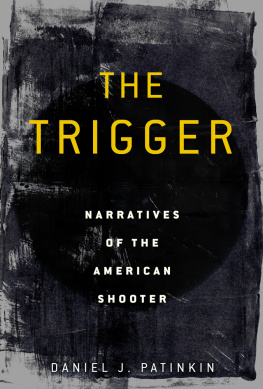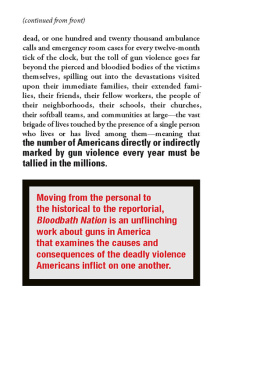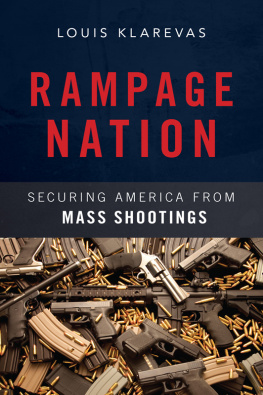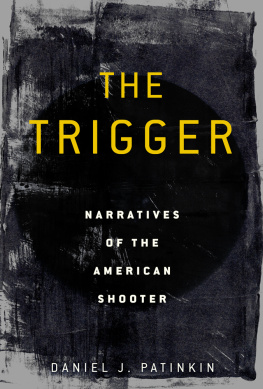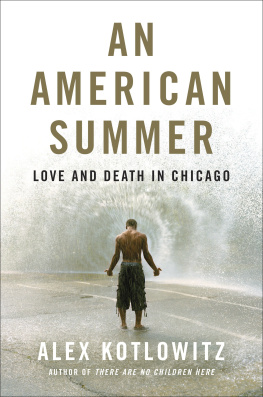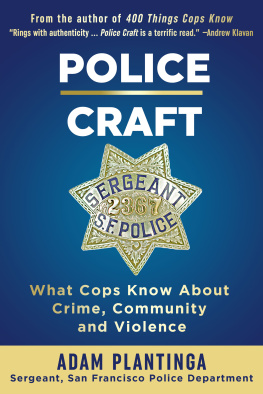

Copyright 2018 by Daniel J. Patinkin
All rights reserved. No part of this book may be reproduced in any manner without the express written consent of the publisher, except in the case of brief excerpts in critical reviews or articles. All inquiries should be addressed to Arcade Publishing, 307 West 36th Street, 11th Floor, New York, NY 10018.
First Edition
For the purposes of privacy and discretion, various names and details pertaining to individuals or events discussed in this book have been modified.
Arcade Publishing books may be purchased in bulk at special discounts for sales promotion, corporate gifts, fund-raising, or educational purposes. Special editions can also be created to specifications. For details, contact the Special Sales Department, Arcade Publishing, 307 West 36th Street, 11th Floor, New York, NY 10018 or arcade@skyhorsepublishing.com.
Arcade Publishing is a registered trademark of Skyhorse Publishing, Inc., a Delaware corporation.
Visit our website at www.arcadepub.com.
Visit the authors sites at www.danielpatinkin.com and www.thetriggerbook.com.
10 9 8 7 6 5 4 3 2 1
Library of Congress Cataloging-in-Publication Data
Names: Patinkin, Daniel J., author.
Title: Narratives of the American shooter / Daniel J. Patinkin.
Description: First Edition. | New York : Arcade Publishing, [2018] | Includes bibliographical references.
Identifiers: LCCN 2018000621 (print) | LCCN 2018014775 (ebook) | ISBN 9781628729207 (ebook) | ISBN 9781628729191 (hardcover : alk. paper)
Subjects: LCSH: Murderers--United States--Biography. | Homicide--United States--Biography. | Firearms and crime--United States. | Firearms--United States.
Classification: LCC HV6785 (ebook) | LCC HV6785 .P38 2018 (print) | DDC 364.152/3092273--dc23
LC record available at https://lccn.loc.gov/2018000621
Cover design by Brian Peterson
Printed in the United States of America
In memory of Brandon Clancy
CONTENTS
INTRODUCTION
It occurs to me that I am America. I am talking to myself again.
Allen Ginsberg
This book presents the life stories of six individuals who have shot someone in the United States. The narratives recounted to me and relayed here are harrowing and starkat times disturbing, at times profound. The revelations contained within them, I hope, will have a lasting impact not only on how you, the reader, perceive the issue of gun violence in this country, but also on how you perceive the American experience in a broader sense. The process of researching and composing this book, indeed, rattled and realigned my own world view. This introduction will address the genesis of this book and the somewhat unusual process that brought it to fruition, along with some reflections on how my personal history and point of view may have impacted the project.
But first, a brief narrative of my own.
I returned to Chicago, my hometown, for the Fourth of July weekend in 2016. On that Friday night, my old friends Malachy, Molly, and Steve joined me for a stand-up comedy show at Zanies in Old Town. One of the comedians who performed told a memorable joke about a public service announcement that he heard on the radio. In the announcement, a famous local rapper pleaded with Chicagoans to stop shooting each other, to put the guns down. The comedian, who was from somewhere else in the United Statessomewhere saferwas appalled that the city of Chicago had resorted to begging to resolve its ever-worsening gun violence problem.
After the show, we rendezvoused with another close friend, Al OConnor (a police officer whose story happens to be featured in this book). Al, Steve, Malachy, and I attended high school together on Chicagos Near West Side, at a Catholic school named St. Ignatius College Prep, before scattering to various Midwestern universities. I was the only one who had later moved away from the city, to Los Angeles. After a few rounds of drinks, Molly called it a night and wethe four guysdecided to continue our revelry at a late-night bar named The Continental, which is on the border of the East Garfield Park and Humboldt Park neighborhoods. During the ride over, our conversation returned to the topic of rampant gun violence in Chicago. I had begun working on this book just a few months prior, and so was curious about how my friends were coping with the widely publicized phenomenon. On this weekend, we were at the halfway point of a year that would see a total of 762 homicides (a 57 percent increase versus 2015) and 4,331 shootings victims (a 46 percent increase) in the citythe worst tally of gun violence in twenty years. My friends were discouraged and aggravated by the carnage and the omnipresent threat, as well as by the extensive and bleak media coverage the issue was getting. Although the situation had been bad in the city since at least the 1960s, the overwhelming, collective sense of despair among Chicagoans in 2016 seems to have reached new heights.
Around two in the morning my group arrived at The Continental, a bar which, despite certain charms, might reasonably be described as a dive. It is patronized in large part by twenty- and thirty-something urban hipsters, many of whom may be hoping for one final chance to get lucky before the sun comes up. We ordered rounds of cheap beer and spent an hour or so reminiscing about our adventures in different parts of the world, including Als somewhat recent bachelor party in the Dominican Republic.
At about 3:30 a.m., there was a sudden commotion. People began rushing in through the front door and elbowing for space. The four of us noticed, but were so absorbed in conversation that we did not address the development until the crowding became oppressive. Squeezed into a spot next to me was a young woman with a disconcerted look on her face.
What the hell is going on? I asked her.
Someone just got shot out front, she responded, panicked and rather pale.
I giggled and gave her a strange look, partly because, in my condition, I was having a hard time processing what she meant, and partly because it sounded like a joke. Hipsters arent exactly known for their gunplay.
What do you mean, Someone just got shot? I asked.
Now I was irritating her. Exactly what I just said! Someone just got shot in front of the bar.
The woman sighed and turned away from me. The gravity of the situation sobered me up. I relayed the information to my friends, who, like me, reacted with some alarm. We decided to stay put and see what developed. A few minutes later, the lights came on. A towering bouncer near the front door announced, The bar is now closed. We need everyone to leave. Please pay your tabs and make your way to the door. My friends and I downed our beers and headed outside.
We emerged onto a crime scene. There were at least a half-dozen police vehicles, along with two ambulances in front of the bar. Down the sidewalk, to the side of The Continental, an area was cordoned off with police tape. A gaggle of bar patrons lingered nearby, waiting for rides and quietly appraising the situation.
Al, youre a cop. You should find out what is going on, I suggested as we made our way down the street.
Nah, man. They seem to have the situation under control, he replied.
We hopped into a Lyft and headed home.
The next morning, I found an article about the incident in the online Chicago Tribune . A thirty-one-year-old man named Hector Badillo Jr. had been shot in the neck. He was standing outside of his fathers automotive shop, next to The Continental, when an unknown assailant emerged from the alley and began firing. Bystanders attempted to treat Badillo, but he was pronounced dead by responding paramedics. One of the stray bullets hit an unaffiliated man in the leg while he sat in a nearby SUV. The motive of the shooter was undetermined.
Next page
